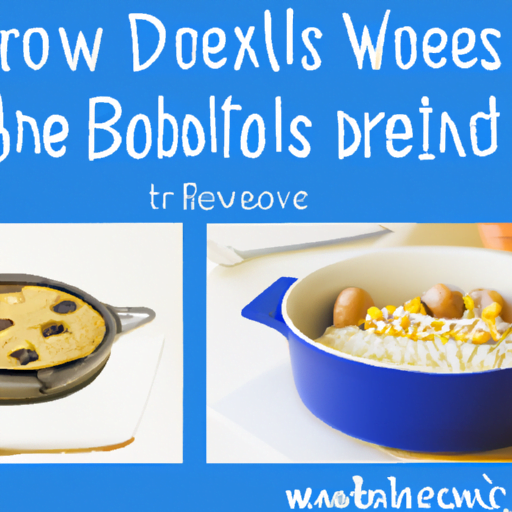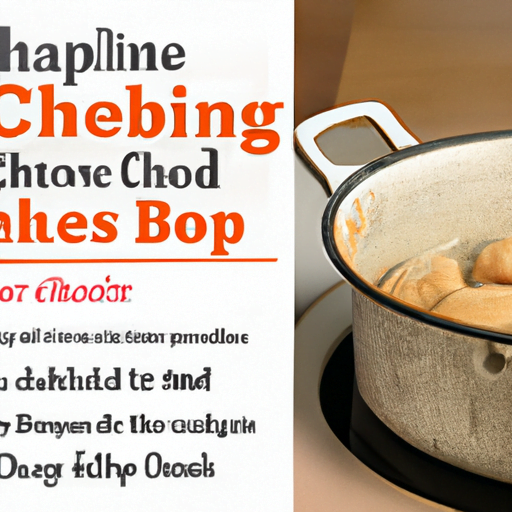How often do you find yourself craving freshly baked goods but don’t have access to an oven? Maybe you’re living off the grid or your oven suddenly broke down. Whatever the reason, not having an oven doesn’t mean you can’t enjoy homemade baked treats. In this article, we’ll discuss alternative techniques for baking without an oven, so you can satisfy your cravings and continue to enjoy delicious baked goods.
Living off the grid can be a challenge, especially when it comes to cooking and baking. But fear not, there are several creative ways you can still bake without an oven. One popular method is using a stovetop. With a stovetop, you can make a variety of baked goods such as cookies, cakes, and bread. Another technique is using a slow cooker. Yes, you read that right – slow cookers can be used for baking too! It may take a bit longer, but the end result is definitely worth it.
If you’re wondering how to bake without an oven, keep reading to find out more about these alternative techniques. We’ll delve into the step-by-step process of baking on a stovetop and using a slow cooker, so you can confidently try them out at home. From choosing the right equipment to adjusting cooking times, you’ll learn everything you need to know to successfully bake without an oven. So, let’s get started and turn your oven-less kitchen into a bakery!

Off Grid Baking
Living off the grid offers numerous benefits, including reduced reliance on public utilities, lower environmental impact, and a greater sense of self-sufficiency. However, one of the challenges faced by off-grid dwellers is how to bake without an oven. In this article, we will explore various alternative techniques for baking without an oven, allowing you to still enjoy delicious baked goods even in a remote off-grid location. Whether you opt for solar cooking, campfire baking, Dutch oven baking, stove-top baking, microwave baking, fireless baking, or steam baking, there are alternative methods available that will still enable you to indulge in your favorite treats. Let’s dive in!
Solar Cooking
One of the most popular methods of off-grid baking is solar cooking. Harnessing the power of the sun, solar ovens can reach high temperatures, making them an excellent alternative to conventional ovens. The principle behind solar cooking is simple – using reflective surfaces to focus sunlight onto a cooking vessel, thus generating heat and allowing for baking.
To build a solar oven, you can use materials such as cardboard, aluminum foil, and glass or plastic covers. First, construct a box using cardboard, ensuring it is well-insulated. Line the inner surface with aluminum foil to maximize the reflection of sunlight. Then, create a clear cover using glass or plastic to trap the heat inside while still allowing sunlight to pass through. Place your baking vessel inside the solar oven, aligning it with the focal point of the reflective surface. As the sun’s rays hit the reflective surface and concentrate on the baking vessel, the heat will gradually bake your goods.
Some delicious recipes that work well with solar cooking include casseroles, bread, cookies, and even pizza. You may need to experiment with cooking times and temperatures, as solar cooking takes longer than traditional baking. However, the rewards of baking with sunlight are well worth the wait, offering a unique and sustainable cooking experience.
Campfire Baking
If you have access to firewood, campfire baking is an excellent option for off-grid baking. The natural heat produced by a campfire can create an oven-like environment, allowing you to bake a wide variety of dishes. However, certain considerations must be taken into account to achieve successful results.
When choosing the right firewood for baking, opt for hardwoods such as oak, hickory, or maple. These woods burn at higher temperatures and provide a consistent heat source. Softwoods like pine or fir should be avoided, as they contain resin that can impart an unpleasant flavor to your baked goods.
To build a campfire oven, start by creating a large fire using the hardwood logs. Once the fire dies down and reduces to a bed of hot coals, rake them into a flat and even surface. Place a metal or cast-iron cooking vessel, such as a Dutch oven or a skillet, directly onto the coals or suspend it over the fire using a cooking tripod. Monitor the temperature of the oven by adjusting the distance between the heat source and the cooking vessel.
Tips for successful campfire baking include rotating the oven occasionally to ensure even heat distribution and using a thermometer to monitor the internal temperature. With practice, you can bake a variety of dishes such as bread, pies, and even cakes over a campfire, adding a rustic charm to your off-grid baking experience.
Dutch Oven Baking
The Dutch oven is a versatile cooking vessel that has been used for centuries for off-grid baking. Traditionally made of cast iron, it is an excellent choice for baking in an off-grid setting. The heavy, durable material retains heat well and distributes it evenly, resulting in deliciously baked goods.
Before using a Dutch oven for baking, it is crucial to season it properly. Seasoning creates a natural non-stick surface and helps prevent rusting. To season your Dutch oven, coat the interior with a thin layer of vegetable oil and heat it over a campfire or in a conventional oven. Repeat this process several times until a smooth, black patina develops on the cooking surface.
Once your Dutch oven is seasoned, you can bake a wide range of dishes, including bread, casseroles, and desserts. When baking bread, preheat the oven by placing hot coals on the lid and underneath the pot. Rotate the pot periodically to ensure even baking. Dutch ovens are highly versatile, allowing you to experiment with different recipes and techniques to achieve mouthwatering results.

Stove-Top Baking
If you have access to a stove but lack an oven, you can still bake using your stovetop. While it may require some adjustments and additional tools, stove-top baking offers a convenient alternative for off-grid living.
Using a stove as an oven involves utilizing the burners to create an oven-like environment. To do this, place a sturdy, oven-safe baking dish on a burner and preheat it on low to medium heat. Adjust the burner’s flame to maintain a consistent temperature, and provide an even baking experience. Remember to monitor the baking dish closely to prevent burning or uneven cooking.
Essential stovetop baking tools may include heat diffusers, which help distribute heat evenly across the baking dish, oven thermometers to monitor temperature accurately, and oven mitts to handle hot dishes safely. With these tools and some creativity, you can bake a variety of dishes, from muffins to soufflés, on your stovetop.
Bread Baking Techniques
Bread baking is a popular form of off-grid baking, and mastering different techniques allows you to create a wide range of delicious loaves. Two notable methods for baking bread without an oven include artisanal bread techniques and no-knead baking methods.
Artisanal bread techniques involve using a preheated cast-iron Dutch oven, similar to Dutch oven baking. By preheating the Dutch oven and baking the bread inside, you can create a crusty exterior, soft interior, and a beautiful oven-spring. This method works well with various types of bread, such as sourdough or whole wheat.
No-knead baking methods are ideal for individuals seeking simplicity and convenience in bread baking. The concept involves a long fermentation period, during which gluten develops without the need for kneading. The dough is then baked in a Dutch oven or covered baking dish to trap steam and create a perfectly baked loaf. No-knead breads can be customized with different ingredients, such as herbs, nuts, or dried fruit, to add variety and flavor.
For individuals with gluten sensitivities or preferences, gluten-free alternatives are also widely available. Experimenting with different gluten-free flours, such as almond flour, coconut flour, or rice flour, can result in tasty gluten-free bread options for off-grid baking.
Microwave Baking
The microwave may not be the first appliance that comes to mind when considering off-grid baking, but it can be a viable option for quick and easy baking tasks. While the microwave lacks the traditional baking experience, it offers convenience and speed, making it suitable for those with limited time or resources.
To bake in a microwave, it is essential to select microwave-safe baking containers that can withstand the heat and pressure generated during the cooking process. Opt for containers made of ceramic or glass, and avoid using plastic or metal, as they can cause sparks or melting.
Quick and easy microwave baking recipes include mug cakes, single-serving brownies, and even breads. These recipes often require simple ingredients and can be prepared in minutes, allowing you to satisfy your cravings in a fraction of the time. While microwave baking may not yield the same texture and browning as traditional baking, it can still provide a tasty and convenient alternative.
Fireless Baking
Fireless baking, also known as retained heat cooking, is a method that utilizes heat retention to bake food. This technique involves using an insulated box, such as a haybox or a Wonderbag, to trap heat and allow the food to cook slowly over time without the need for an external heat source.
The principles behind fireless baking are simple. First, bring your ingredients to a boil in a pot or a Dutch oven on a stovetop or a campfire. Once the food is boiling, carefully transfer the hot pot into the insulated box, ensuring it is tightly sealed. The insulation will preserve the heat, allowing the food to continue cooking without an additional heat source.
Fireless baking is ideal for slow-cooked dishes such as stews, casseroles, or braised meats. By planning in advance and utilizing this method, you can still enjoy warm, perfectly cooked meals even without a traditional oven.
Steam Baking
Steam baking is a technique commonly used in professional bakeries to achieve crusty breads and delicate pastries. It involves incorporating steam into the baking process to create texture and help dough rise. While steam ovens or pots may not be readily available in an off-grid setting, there are ways to achieve steam baking at home.
To create steam in a conventional oven, place a tray filled with water on the bottom rack and preheat the oven as usual. The water evaporates during the baking process, creating steam that ensures hydration and promotes a crisp crust on bread or a flaky texture in pastries.
Mastering steam baking techniques requires careful attention to time and temperature. Too much steam can result in a soggy product, while too little can lead to a dry or overly dense baked good. With practice and experimentation, you can develop a mastery of steam baking, allowing you to create professional-quality bread and pastries in an off-grid setting.
Conclusion
Exploring alternative techniques for baking without an oven opens up a world of possibilities for off-grid living. Whether you choose solar cooking, campfire baking, Dutch oven baking, stove-top baking, microwave baking, fireless baking, or steam baking, each method offers its unique advantages and challenges. By embracing these techniques, you can continue to enjoy the pleasures of baking and satisfy your cravings even in the absence of modern kitchen appliances. So, go forth and embrace the challenges, adapt to off-grid living, and discover the joy of sustainable baking!




